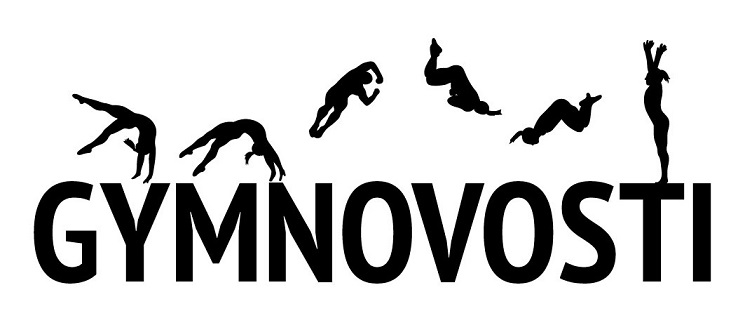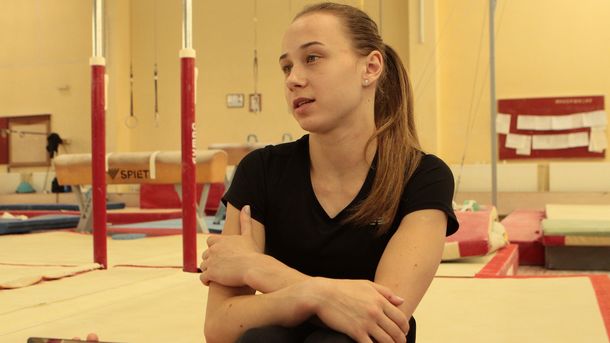Diana Varinska gave an interview to Segodnya.ua about her preparation for Euros and Worlds.
She met with the interviewer right after the verification practice in which the team did their routines in the competition mode and were judged:
A: These verification practices are given scores, just like at competitions. Everything is going more or less well. But I think I’ll downgrade bars a bit in qualification just to be sure I’ll do them well. And if I’ll make the event final, I’ll upgrade them.
Q: Are you trying something new? Some new elements?
A: Only one – on bars, Hindorff.
Q: What do you think about the first half of the season?
A: I went to two World Cups. At the first one, in Doha, I competed badly: I didn’t make any finals. I tried to do my new bars routine there and fell. But in Croatia, I won three gold medals: on bars, beam, and floor. And I competed well at the Ukrainian Cup. The biggest difficulties are on bars because they’re the hardest to train to perfection. But it’s my best event. At Euros, I’d like to make the team final. On individual events, I mostly count on making the bars final, but I could also try on beam.
Q: Who do you consider the favorite to win at Euros?
A: The Russians are strong. The Dutch? Yes, they are, too. And the British.
Q: Not all the gymnasts pay attention to how aesthetically pleasing they look during their routines. Ukrainians, I notice, usually don’t have this issue…
A: We are paying attention to this. We have barre lessons. And there are deductions for the lack of artistry. We have to point our toes because otherwise, the routines look worse. On floor, you can lose up to 2.5 points! You can tumble well but if your movement isn’t pretty or doesn’t go along with the music, this will be punished.
Q: Who is an example for you in gymnastics? Whose style do you like?
A: My idol is the American Nastia Liukin. She’s not competing anymore. She had high difficulty but at the same time, she’s a very beautiful and elegant gymnast.
Q: Would you want to try an unusual character [on floor]? For example, like Eythora Thorsdottir from the Netherlands, who portrayed a zombie ballerina?
A: I don’t think I’d be able to. You have to work a lot on emotions, facial expressions – I just can’t do that. But I could try.
Q: A commentator once called you the Snow Queen. Do you think this comparison is fair? And what nicknames your friends have for you?
A: I don’t know, maybe others know better. I don’t have nicknames. Although our masseuse lovingly calls me “Varenik”*. This doesn’t offend me.
Q: This weekend Simone Biles returned to the competition for the first time since the 2016 Olympics. What does it mean for gymnastics and for you personally?
A: I think she’s unbeatable. Simone is like from another planet, I don’t understand how she is doing all that. I think she’s the winner for the next four years. Her comeback is motivating, you strive to get closer to her. But her bars aren’t so difficult. There she can be beaten. But she’s very strong on tumbling events. I saw a video – she’s already doing almost everything she did before.
Q: What do you like doing besides gymnastics? You have to get a rest from gymnastics sometimes.
A: I go to the movies, just to refresh my mind. I have a dog, Mia, I’m walking with her, she lives here, at the Olympic training center. And I have a pit bull at home. I like cooking even though I rarely cook. It’s usually something sweet. Last time, I think, I baked a pie.
Q: And are you allowed to?
A: Yes, we don’t have restrictions on sweets, pastries, chocolate. There’s a certain weight you have to be in. And it doesn’t matter what you’re eating. But I can’t eat how much stuff I want, I have to control myself. The extra weight is immediately felt in training – you can get injured because your body doesn’t feel right.
Q: In rhythmic gymnastics, the creating of the leo has a very important role. And what about artistic gymnastics?
A: We had a contract with a company and we couldn’t affect the designs, we chose from a catalog. Last year I had only two competition leos. I’d like some variety, something prettier. But now the contract is finished and at Euros, we can compete in whatever leos we want.
Q: What is your favorite element?
A: On my favorite event, bars, I like Tkachev plus [Jaeger] salto, this combination isn’t done by anyone right now. It’s my signature combination.
Q: Is it important for you to train near such stars as Verniaiev and Radivilov?
A: It’s good that we’re working in the same gym as such people – it motivates us, we have someone to look up to. Igor sometimes gives advice, helps to train vault.
Q: By the way, have you ever tried doing men’s events?
A: I tried a bit on pommel horse but I wasn’t able to do anything. I don’t even understand how they’re doing anything on it. You have to have a special technique – perhaps, if someone taught me, I’d be able to do it, but I can’t learn by myself. And I’m afraid to do parallel bars.
Q: What is the current internal competition on the national team?
A: It’s a bit more competitive now. There’s a good girl on the junior team – Nastia Bachynska. In her difficulty she almost reached me. She’s going to Euros on the junior team and next year we will be competing together on the senior team.
Q: What is the reason for the rising level of women’s artistic gymnastics in our country?
A: I think it’s because we have a new head coach – Oleg Ostapenko. He created a new program for practices, warm-ups, and conditioning. Before, we usually didn’t do long warm-ups – you warmed-up quickly and went to the apparatuses. With Oleg Vasilyevich, we now start with conditioning sessions. Then we do a warm-up but not just five minutes, we do a difficult one, with tumbling. Then we do the four events. These warm-ups are needed in order to be able to do more work. With more conditioning, we started to do better on the apparatuses, too.
Q: When is it harder to train – in the morning, during the day or in the evening?
A: I like training in the evening. In the morning, my body is still heavy. But for Nastia Bachynska, for some reason, mornings are easier. It’s all individual.
Q: How many Olympics would you like to go to?
A: At least two. Before, I thought – the 2020 will pass and that’s it. But then I thought – what am I going to do afterwards? I’ll only be 19 years old, I can keep training. But first I need to make it to the Olympics.
*Russian/Ukrainian type of dumpling
Photo: Segodnya.ua
Support Gymnovosti on Patreon from only $1 a month and help us bring to you even more awesome gymnastics coverage!



